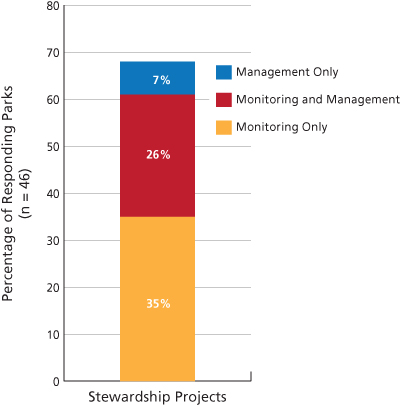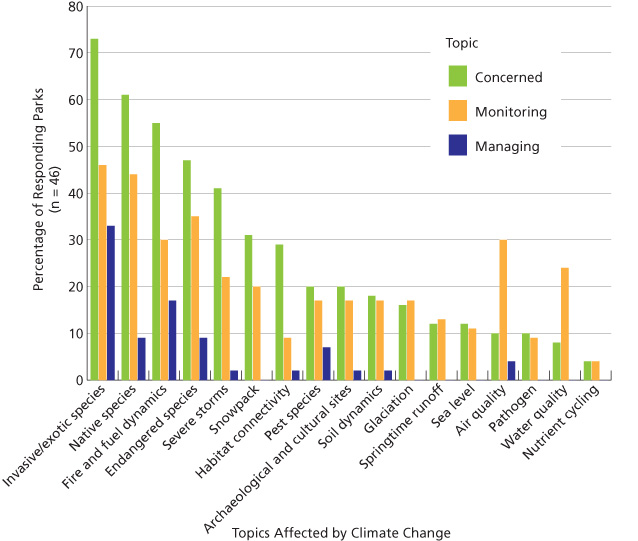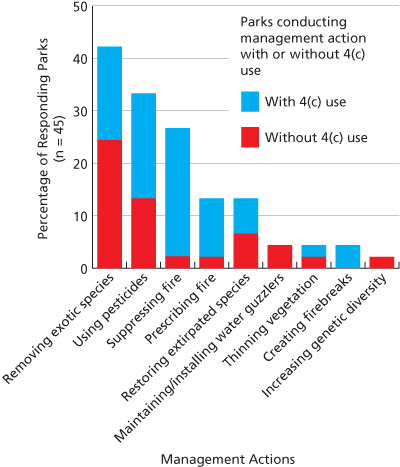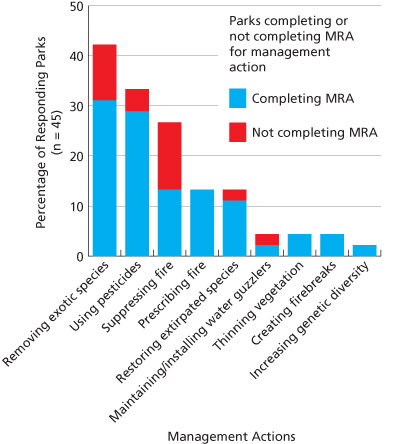The hands-off approach is said to benefit the untrammeled quality as the active approach benefits the natural quality.
Get PDF
Download PDF of this article
Abstract and key words
Abstract: Wilderness advocates debate whether climate change warrants an active or passive approach to wilderness stewardship. Surveying the 49 units of the National Park System that administered designated wilderness in 2012 and early 2013, this baseline study describes the active approach to wilderness stewardship in a climate change context. The response rate was 94%. A majority of the responding parks report taking action in wilderness in response to climate change. Respondents also reported that these activities affected wilderness character. This response will be welcomed by some and worrisome to others. Nevertheless, the lens of wilderness character continues to provide appropriate and necessary complexity to evaluate stewardship responses.
Key Words: climate change, Joshua Tree National Park, prohibited uses, wilderness character
Article
WITH THE NATION CELEBRATING THE 5OTH ANNIVERSARY OF THE WILDERNESS ACT IN 2014, we have had an opportunity to reflect on how wilderness stewardship is evolving in response to today’s challenges. By drawing artificial boundaries across the landscape, the act was intended to preserve federal lands from impacts wrought by unrestrained use and management. Yet boundaries do not protect these lands from the pervasive effects of climate change. To preserve wilderness character and address a dilemma unforeseen by the act’s visionaries, wilderness managers must grapple with a number of potential responses. For example, in the wake of climate change, Joshua Tree National Park is predicted to lose many of its Joshua trees (Cole et al. 2011). The following list expresses hypothetical scenarios for what wilderness managers might consider in this context (adapted from Cole and Yung 2012):
- Wilderness managers could allow the use of drip irrigation to maintain the namesake species in its current range. But should they?
- What about introducing Joshua trees to other areas of the wilderness that are expected to harbor more favorable habitat in the future?
- Or perhaps they could introduce other “neo-native” species to areas left in the wake of dying Joshua trees?
- Should park officials refrain from such interventions and instead allow “nature” to take its course—accepting whatever evolves as a novel ecosystem?
- Would pursuing management restraint justify increased monitoring to document and learn from Joshua tree retreat?
- What if this monitoring compromises other wilderness qualities?
These are the kinds of questions facing wilderness managers in parks across the nation. Impacts of climate change vary with the diversity of the nation’s parks. It may be sea-level rise along the coasts, melting glaciers, insect outbreaks, migrating species, decreasing snowpacks, altered fire regimes, or changing visitor-use seasons. At base, climate change begs the question, “How should we respond?” Even in the midst of this change, the Wilderness Act (1964) requires wilderness character to be preserved using only the minimum actions and tools to the extent necessary.
Section 4(c) of the Wilderness Act prohibits certain uses such as motorized equipment, mechanical transport, and construction of permanent structures and installations, among others. Prohibited uses may be employed in certain circumstances, e.g., if the use is deemed “necessary to meet minimum requirements for the administration of the area” for the purpose of wilderness.
National Park Service (NPS) policy requires parks to complete a Minimum Requirements Analysis (MRA) prior to undertaking wilderness management activities. MRAs help managers and scientists employ a thoughtfully targeted approach to preserving wilderness character. They document the determination of whether a proposed action involving a prohibited use or an action that could potentially affect wilderness character is necessary to meet the minimum requirements for the administration of the area for the purpose of wilderness. When environmental assessments or environmental impact statements are prepared for projects in wilderness, an MRA should be included as part of the document.
The interagency Arthur C. Carhart National Wilderness Training Center has developed resources to help wilderness managers prepare MRAs. The NPS Stewardship Division provides guidance on how to effectively carry out that responsibility.
Although the Wilderness Act requires wilderness character to be preserved, it neglects to define this concept. Keeping It Wild, an interagency strategy to monitor wilderness character, has defined five qualities of wilderness character: untrammeled, undeveloped, natural, solitude or primitive and unconfined recreation, and other features of value (Landres et al. 2008). These qualities have been lifted directly from the definition of wilderness as stated in the act. They are commonly considered in MRAs and in wilderness character monitoring.
Despite such guidance, there remains a lively academic debate over whether climate change warrants an active or hands-off approach to wilderness stewardship. Should wilderness managers and scientists exercise a responsibility to do everything they can to monitor and adapt to climate change in these most protected places? (See, e.g., Frelich and Reich 2009.) Or should they instead exercise humility through restraint and learn from unmanipulated benchmarks while avoiding unintended consequences (as described by Landres 2010)? The debate tends to be framed as a trade-off between two qualities of wilderness character: natural and untrammeled (Cole 2001). The hands-off approach is said to benefit the untrammeled quality as the active approach benefits the natural quality. However, this trade-off ignores the other qualities of wilderness character, which also figure into wilderness management planning.
Because there is no nationwide database to document wilderness stewardship activities and their effects upon wilderness character, the current debate highlights individual case studies and hypothetical scenarios. However, this study provides the first glimpse at wilderness stewardship on the national scale by describing responses to climate change in NPS-administered wilderness. As a result, this study gives those discussing appropriate stewardship approaches the fabric within which to sew their arguments.
Results

With a response rate of 94%, participants described stewardship responses to climate change in wilderness and how these activities affect wilderness character. Respondents had spent an average of 9.4 years working in their park. They had also accumulated an average of 11.4 years of experience working in wilderness stewardship. Respondents held a variety of positions. Many were chiefs of resource management or chief rangers. Biologists and geologists also responded. Some superintendents filled out the survey themselves. About one-half (48%) of the 46 respondents indicated that they served as the wilderness coordinator for their park. Their different backgrounds, training, and areas of expertise may have affected how questions were interpreted and how participants responded.
Stewardship activities
Climate change prompted ongoing wilderness stewardship activities in more than two-thirds of responding parks (fig. 1). Response to climate change in NPS-administered wilderness amounted to 120 monitoring projects and 27 management projects.
The responses described here likely underestimate the overall stewardship response to climate change in NPS-administered wilderness. Several respondents commented that additional stewardship activities went unreported in the survey because these activities, though related to climate change, had not specifically been designed to address its effects. Other respondents noted that their park was just beginning to consider the effects that climate change would have in their wildernesses.

Exotic species, native species, endangered species, and fire were the topics most commonly addressed in park wilderness with respect to climate change (fig. 2). “Exotic and invasive species” was the most commonly monitored and managed topic as well as the most commonly ranked concern.

Respondents reported information about specific management actions addressing climate change in wilderness (figs. 3 and 4). desired species.
Despite constraints stated in the Wilderness Act, prohibited uses were approved for 60% of management actions responding to climate change in NPS wilderness (fig. 3). Although actions associated with exotic and invasive species were common, these actions were also among the least likely to have employed a prohibited use. Prohibited uses were more likely for management activities related to fire. Climate change activities associated with fire allowed prohibited uses 93% of the time. However, these data do not indicate what kinds of prohibited uses were being allowed. Were they using a wheeled cart to carry tools or a helicopter to put out fires? A follow-up study could clarify the degree of intervention.

Visitor use
Nearly half of respondents described shifts in wilderness visitor use that they attributed to climate change. The most frequently reported shift was a longer visitation season, which was linked to early snowmelt, mild winter conditions, or long open-water seasons. Other parks reported decreases in visitor use attributed to severe storms, fire danger, or hurricane debris.
In response to these shifts, about a quarter of the responding parks had altered their approach to visitor management. Two parks increased wilderness patrols during the traditional shoulder seasons while the others repaired infrastructure impacted by erosion and storms.
Wilderness character
Respondents reported that climate change–driven stewardship activities improved or degraded qualities of wilderness character in complex ways (table 1). Stewardship activities tended to improve the natural quality of wilderness character more frequently than they did other qualities. A handful of respondents expanded wilderness character to include additional benefits outside of the qualities defined in Keeping It Wild. Some respondents concluded that “scientific research” improved wilderness character because it increased knowledge about wilderness and could inform management decisions. Two respondents considered the effect of “enabling legislation” on wilderness stewardship. Enabling legislation includes laws that establish park units or designate wilderness and often name valued features in the landscape that warrant protection. Some respondents considered preservation of these features as a way to improve wilderness character.
| Table 1. Effects of active stewardship on qualities of wilderness character as reported by 45 units of the National Park System that administer designated wilderness | ||
|---|---|---|
| Quality of Wilderness Character* | Frequency of Parks Reporting Improvements | Frequency of Parks Reporting Degradations |
| Untrammeled: Unhindered and free from the actions of modern human control or manipulation | 1 | 11 |
| Undeveloped: Retains its primeval character and influence and is essentially without permanent improvement or modern human control or manipulation | 9 | 7 |
| Natural: Its ecological systems are substantially free from the effects of modern civilization | 12 | 4 |
| Solitude or primitive and unconfined recreation: Provides opportunities for solitude or primitive and unconfined recreation | 0 | 9 |
| Other features of value: Unique to an individual wilderness based on features that are in that wilderness. (As stated in the Wilderness Act, wilderness “may also contain ecological, geological, or other scientific, educational, scenic, or historical value.”) | 1 | 0 |
| *Quality of wilderness character descriptions are quoted from Landres et al. 2012. | ||
Respondents reported that wilderness stewardship activities degraded many qualities of wilderness character. The untrammeled quality was most frequently degraded. Some respondents volunteered the causes of trammeling: the construction of bridges, removal of invasive and exotic species, planting, rerouting trails, control of fire, installation of monitoring stations, and the use of helicopters. Several respondents reported that stewardship activities had degraded the undeveloped quality (with monitoring activities and installations) and the opportunities for solitude or primitive and unconfined recreation quality (planting, monitoring, flying helicopters, constructing bridges, installing climate change detection equipment, and restricting the use of or closing areas due to severe storms). A handful of respondents also indicated that the natural quality had been degraded by stewardship activities designed to address the effects of climate change in wilderness. Some of these degradations stemmed from installations, aircraft, and bridges. Some respondents described impacts as minor or temporary.
Discussion
The topics addressed by wilderness stewardship activities are complex and often interrelated. One stewardship activity may affect several components of an ecosystem and thus several of the topics examined in this study. Some topics, such as native species, may be more common across parks, and thus more often addressed. Others, such as endangered species, air quality, and water quality, may require attention to comply with legal obligations (e.g., the Endangered Species Act, Clean Air Act, and Clean Water Act). However, the responses in this study reflect topics that elicit stewardship responses in the context of climate change.
These findings highlight climate change–related budget and staffing challenges as well as policy considerations. Many wilderness programs will have to adapt to longer visitor-use seasons. This will have repercussions for visitor centers, permit offices, trail crews, and backcountry patrols. Other wilderness programs may need guidance to balance legal obligations set forth in enabling legislation with those defined by the Wilderness Act.
As more parks consider responding to climate change in wilderness, these findings suggest there may be subsequent repercussions for wilderness character. Choosing to actively manage wilderness may not necessarily be a simple trade-off benefitting the natural quality and degrading the untrammeled one. Several other qualities may be affected as well.
Minimum Requirement Analysis is a tool to help wilderness managers navigate the complicated process of preserving wilderness character. Even though NPS policy requires MRAs for stewardship activities in wilderness, participants in this study indicated that these analyses were ignored a quarter of the time. Some of these actions had to do with suppressing fire. Response to fire may be considered under the Wilderness Act’s Section 4(d), Special Provisions. However, NPS Policy 6.3.9 notes that “preplanning is critical to ensure that emergency response incorporates minimum requirements to the greatest extent possible.”
Although there are recommended strategies for completing MRAs (see wilderness.net/MRA), there is no standardized MRA methodology required by NPS policy. Without this standardization and a centralized catalog of MRAs, administrative oversight may be lacking.
To ensure that the various qualities of wilderness character are adequately considered in the decision process, it may be prudent to create a database to catalog completed MRAs. As a first step, existing NPS databases that record scientific activities could track whether these activities were occurring in wilderness and whether MRAs had been completed. Cataloging MRA completion rates for other types of wilderness management activities would require an additional database. By tracking this information, these databases would continue to build on the work of the NPS Wilderness Stewardship Division to develop a broader understanding among wilderness managers and park scientists of wilderness and wilderness character. They could also provide a layer of accountability and oversight.
Conclusion and acknowledgments
These findings characterize the active approach to wilderness stewardship. They demonstrate that designated wilderness is neither pristine nor free from human activity—whether human-induced climate change or stewardship responses. As such, this study describes the existing relationship between people and wilderness.
Together these data develop a rough sketch for the level and diversity of National Park Service responses to climate change in wilderness. Follow-up studies will be needed to fill out the picture. The data do not indicate the extent of area affected, the frequency of response, or its duration. Nevertheless, these baseline survey data do provide a preliminary sense of the range of topics addressed in wilderness vis-à-vis climate change. Importantly, they demonstrate the number of decision points at which park scientists and wilderness managers opted to actively respond to climate change.
By breaking wilderness character into different qualities, wilderness managers and others can recognize the real and complicated relationship that humans have with nature, wildness, and wilderness. Wilderness character allows us to articulate how stewardship activities may harm some qualities of wilderness while improving others. It also enables wilderness managers to distinguish how management restraint may harm some qualities while improving others. Wilderness character empowers managers and scientists to recognize that restraint is a valid and deliberate approach to the human-nature relationship.
Fundamentally, wilderness character enables us to move beyond generalizing human actions as “good” or “bad” with respect to nature. Rather, it provides the framework through which to recognize, articulate, and study the real and complicated relationship that humans have with nature and wilderness—especially in the context of climate change. Climate change, a phenomenon that operates at a non-park-specific scale, may make NPS response seem insignificant, even arbitrary. However, the response to climate change in wilderness teaches us to recognize the messy, unpredictable, and adaptable nature of the world we live in. It also teaches us that we can tackle the impacts of climate change with thoughtful resolve or we can exercise a deliberate restraint that accepts, mourns, values, and celebrates the world’s ability to adapt.
Acknowledgments
Many thanks to Garry Oye, Erin Drake, Neva Hassanein, Peter Landres, and Dan Spencer. This study was funded by the B. B. Dawson Memorial Fund, Bertha Morton Scholarship, Pat Williams Scholarship, Wyss Scholars Program, RM-CESU Partnership, and Waincko Family Scholarship.
References
Cole, D. N. 2001. Management dilemmas that will shape wilderness in the 21st century. Journal of Forestry 99:4–8.
Cole, D. N., and L. Yung. 2012. Beyond naturalness: Rethinking park and wilderness stewardship in an era of rapid change. Island Press, Washington D.C., USA.
Cole, K. L., K. Ironside, J. Eischeid, G. Garfin, P. B. Duffy, and C. Toney. 2011. Past and ongoing shifts in Joshua tree distribution support future modeled range contraction. Ecological Applications 21:137–149.
Frelich, L. E., and P. B. Reich. 2009. Wilderness conservation in an era of global warming and invasive species: A case study from Minnesota’s Boundary Waters Canoe Area Wilderness. Natural Areas Journal 29:385–393.
Landres, P. 2010. Let it be: A hands-off approach to preserving wildness in protected areas. Pages 88–105 in D. N. Cole and L. Yung, editors. Beyond naturalness: Rethinking park and wilderness stewardship in an era of rapid change. Island Press, Washington, D.C., USA.
Landres, P., C. Barnes, J. G. Dennis, T. Devine, P. Geissler, C. S. McCasland, L. Merigliano, J. Seastrand, and R. Swain. 2008. Keeping it wild: An interagency strategy to monitor trends in wilderness character across the National Wilderness Preservation System. General Technical Report RMRS-GTR-212. USDA Forest Service, Rocky Mountain Research Station, Fort Collins, Colorado, USA.
Landres, P., W. M. Vagias, and S. Stutzman. 2012. Using wilderness character to improve wilderness stewardship. Park Science 28(3):44–48.
Wilderness Act of 1964. Public Law 88-577 (16 U.S.C. 1131–1136). 3 September.
About the author
Katie Nelson has an M.S. in Environmental Studies from the University of Montana. She currently works at the Wild Rockies Field Institute in Missoula, Montana. She can be reached by e-mail.
Documentation
Suggested citation for this article
Nelson, K. 2015. The National Park Service response to climate change in wilderness. Park Science 32(1):13–18.
This article published
Online: 4 September 2015; In print: 14 September 2015
URL
https://www.nps.gov/ParkScience/articles/parkscience32_1_13-18_nelson_3816.htm
This page updated
16 September 2015
Site navigation
Part of a series of articles titled Climate Change in Nth California and Sth Oregon .
Last updated: August 9, 2018
